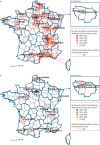Severe asthma care trajectories: the French RAMSES cohort
- PMID: 38651091
- PMCID: PMC11033728
- DOI: 10.1183/23120541.00837-2023
Severe asthma care trajectories: the French RAMSES cohort
Abstract
Background: The French RAMSES study is an observational prospective multicentre real-life cohort including severe asthmatic subjects. The objective of the study was to compare the characteristics of patients, in terms of phenotype and asthma care trajectories, between those managed by tertiary referral centres (TRCs) or secondary care centres (SCCs).
Methods: Patients were prospectively recruited and enrolled for a 5-year follow-up. Patients' characteristics were analysed at inclusion and compared between TRCs and SCCs.
Results: 52 centres (24 TRCs and 28 SCCs) included 2046 patients: 1502 (73.4%) were included by a TRC and 544 (26.6%) by a SCC. Patients were mainly women (62%), 53±15 years old, 67% with Asthma Control Test <20; at inclusion, 14% received oral corticosteroids (OCS) and 66% biologics. Compared with the SCC group, the TRC group had more frequent comorbidities and lower blood eosinophil counts (262 versus 340 mm-3; p=0.0036). OCS and biologics use did not differ between groups, but patients in the TRC group benefited more frequently from an educational programme (26% versus 18%; p=0.0008) and received more frequently two or more sequential lines of biologics (33% versus 24%; p=0.0105). In-depth investigations were more frequently performed in the TRC group (allergy tests: 74% versus 62%; p<0.0001; exhaled nitric oxide fraction: 56% versus 21%; p<0.0001; induced sputum: 6% versus 3%; p=0.0390).
Conclusions: Phenotypes and care trajectories differed in the RAMSES cohort between SCCs and TRCs, probably related to different levels of asthma severity and differences in medical resources and practices among centres. This highlights the need for standardisation of severe asthma care.
Copyright ©The authors 2024.
Conflict of interest statement
Conflict of interest: J-M. Perotin reports lecture honoraria from AstraZeneca, support for attending meetings from AstraZeneca and Chiesi, and membership of working groups and associations receiving financial support from AstraZeneca, Chiesi, Novartis and Sanofi; outside the submitted work. N. Just participated or participates as an investigator in clinical trials with Chiesi, and reports honoraria from Chiesi and AstraZeneca. G. Devouassoux reports lecture honoraria from AstraZeneca, Boehringer Ingelheim, Chiesi, GlaxoSmithKline, Mundi Pharma, Novartis Pharma, Vivisol, Sanofi, ALK and Menarini; consultancy fees from AGIR Adom, ALK, AstraZeneca, Boehringer Ingelheim, Chiesi, GlaxoSmithKline, Meda, MSD, Novartis Pharma, Orkyn, Takeda, TEVA, Sanofi and Cipla; has served as a principal investigator and/or study coordinator for AB Science, ALK, Amgen, AstraZeneca, Boehringer Ingelheim, GlaxoSmithKline, Lilly, Novartis Pharma, Roche, Regeneron Pharmaceuticals Inc., Sanofi, TEVA, VitalAire, Gossamer and Zambon; and reports research grants from AGIR Adom, ALLP, Chiesi, GlaxoSmithKline, MSD, Novartis Pharma, Orkyn, Takeda and Vivisol. C. Chenivesse reports grants from AstraZeneca, GlaxoSmithKline, Novartis and Santelys, personal fees from ALK-Abello, AstraZeneca, Boehringer Ingelheim, Chiesi, GlaxoSmithKline and Sanofi, and congress support from AstraZeneca, Boehringer Ingelheim, Chiesi, Novartis and Sanofi. C. Saint Raymond reports lecture honoraria, support for attending meetings, and membership of working groups and associations receiving financial support from AstraZeneca, Novartis, GlaxoSmithKline and Sanofi. A. Bourdin reports grants from Boehringer Ingelheim, AstraZeneca, GlaxoSmithKline, AB Science, Celltrion, Cipla, Areteia, Novartis, Sanofi Regeneron and Chiesi, consulting fees, lecture fees and support for meetings from Boehringer Ingelheim, AstraZeneca, GlaxoSmithKline, AB Science, Celltrion, Cipla, Novartis, Sanofi Regeneron and Chiesi, and participation on an advisory board for AB Science. G. Garcia reports personal fees from AstraZeneca, Sanofi, Novartis, Chiesi and GlaxoSmithKline, and congress support from Sanofi and Oxyvie. A. Boudjemaa reports personal fees from AstraZeneca, Sanofi, Chiesi and GlaxoSmithKline, and congress support from GlaxoSmithKline and Oxyvie. P. Bonniaud reports research grants from AstraZeneca, personal fees from AstraZeneca, Boehringer Ingelheim, Sanofi, Novartis and GlaxoSmithKline, and congress support from AstraZeneca, Sanofi, Boehringer Ingelheim, Stallergenes and Novartis. P. Chanez reports grants, consulting fees, lectures fees and support for meetings from ALK, AstraZeneca, Biopharm, Boehringer Ingelheim, Chiesi, GlaxoSmithKline, Novartis and Sanofi-Aventis. C. Barnig reports support for attending meetings from AstraZeneca, GlaxoSmithKline, Sanofi, ALK and Chiesi. A. Beurnier reports lecture fees from AstraZeneca and Sanofi. N. Freymond reports lecture honoraria from AstraZeneca, Sanofi and GlaxoSmithKline, and support for attending meetings from AstraZeneca and Sanofi; outside the submitted work. C. Tcherakian reports a grant from Air Liquide Foundation, lecture fees from AstraZeneca, GlaxoSmithKline, Chiesi, Novartis and Sanofi, and meeting support from Sanofi and GlaxoSmithKline. M. Drucbert reports lecture honoraria from GlaxoSmithKline and AstraZeneca, and membership of working group receiving financial support from AstraZeneca; outside the submitted work. S. Guillo reports no personal fees, congress support or research grants with conflicting interests to disclose other than the funding of the RAMSES cohort. C. Estellat reports no personal fees, congress support or research grants with conflicting interests to disclose other than the funding of the RAMSES cohort. C. Taillé reports lecture or advisory board fees and grants from AstraZeneca, Sanofi, GlaxoSmithKline, Chiesi, Stallergenes and Novartis. All other authors have nothing to declare. There are no further conflicting interests to disclose.
Figures
References
LinkOut - more resources
Full Text Sources
Research Materials

